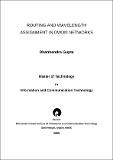Please use this identifier to cite or link to this item:
http://drsr.daiict.ac.in//handle/123456789/74| Title: | Routing and wavelength assignment in DWDM networks |
| Authors: | Roy, Anil K. Gupta, Dharmendra |
| Keywords: | DWDM Dense Wavelength Division Multiplexing Wavelength Division Multiplexing Optical communications Optical networks |
| Issue Date: | 2005 |
| Publisher: | Dhirubhai Ambani Institute of Information and Communication Technology |
| Citation: | Gupta, Dharmendra (2005). Routing and wavelength assignment in DWDM networks. Dhirubhai Ambani Institute of Information and Communication Technology, vii, 109 p. (Acc.No: T00037) |
| Abstract: | All-Optical Networks employing Dense Wavelength Division Multiplexing (DWDM) are believed to be the next generation networks that can meet the ever-increasing demand for bandwidth of the end users. The problem of Routing and Wavelength Assignment (RWA) has been receiving a lot of attention recently due to its application to optical networks. Optimal Routing and Wavelength Assignment can significantly increase the efficiency of wavelength-routed all-optical networks. This thesis presents some new heuristics for wavelength assignment and converter placement in mesh topologies. Our heuristics try to assign the wavelengths in an efficient manner those results in very low blocking probability. We propose novel static and dynamic assignment schemes that outperform past assignment schemes reported in the literature, even when converters are used. The proposed on-line scheme called Round-Robin assignment outperforms previously proposed strategies such as first-fit and random assignment schemes. The performance improvement obtained with the proposed static assignments is very significant when compared with the dynamic schemes. We designed and developed a simulator in Matlab6.5 that supports the 2D mesh topology with DWDM as well as random topology generation. We ran extensive simulations and compared our heuristics with those reported in the literature. We have examined converter placement in mesh topologies and proposed that placing converters at the center yields better results than uniform placement when dimension order routing is employed. We introduced a new concept called wavelength assignment with second trial that results in extremely low blocking probabilities when compared to schemes based on a single trial. Our proposed schemes are simple to implement and do not add to the cost. Thus we conclude that wavelength assignment plays more significant role in affecting the blocking probability than wavelength converters. The algorithm yields significant improvements in terms of the request blocking probability over traditional techniques. Also we have observed from simulated results that by using even limited conversion of degree two is sufficient to achieve performance of full conversion. We have achieved this performance by using our better heuristic technique of establishing light paths. |
| URI: | http://drsr.daiict.ac.in/handle/123456789/74 |
| Appears in Collections: | M Tech Dissertations |
Files in This Item:
| File | Description | Size | Format | |
|---|---|---|---|---|
| 200311010.pdf Restricted Access | 1.48 MB | Adobe PDF |  View/Open Request a copy |
Items in DSpace are protected by copyright, with all rights reserved, unless otherwise indicated.
